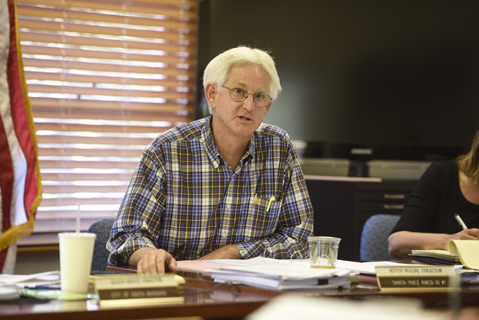Water Woes Go From Bad to Worse
Pumping Barge May Need a $2.5 Million Move

The bad news is that Lake Cachuma now holds less than half the water it did at the beginning of the year, and levels have dropped so low that dam operators activated emergency pumps this Monday evening to lift the water via a 3,200-foot pipeline into the lowest rung of the dam’s portal tower. That tower is normally gravity fed, but with levels plunging four inches a day, gravity needs mechanical assistance to get dam water into the distribution system — via the Tecolote Tunnel — that serves 200,000 customers.
In even worse news, water levels are falling so precipitously that the emergency pumping system — operating from a barge on the lake — may need to be moved 6,200 feet toward the deeper waters of the reservoir. This relocation could cost as much as $2.5 million. That’s on top of the $5.5 million already spent to build the barge-based emergency pumping system.
Complicating matters immensely is the conspicuous lack of harmony among the various water districts that make up the membership of the Cachuma Operations and Maintenance Board (COMB). For any expenditure of $1 million or more, a unanimous vote is required. At least one member agency — the Santa Ynez Water Improvement District 1 — has already indicated it would vote against such a move even though the Santa Ynez district would not be on the hook for any of the costs. “Because they’re stealing our water,” explained Kevin Walsh, the Santa Ynez representative to the COMB board.
Walsh insisted that the South Coast water agencies are entitled to draw water only from dam elevations of 750 feet down to 660. Once the dam dips below 660, he said, South Coast agencies will be taking water to which they’re not legally entitled. According to COMB’s acting director Janet Gingras, the pump barge will need to be moved once the elevation drops below 658 feet.
Complicating matters even further, dam operators with COMB need to give 90-days advance notice to the contractor who built and operates the pumping barge. That deadline, in November, occurs before winter rains typically fall. In an effort to buy time — to delay making a $2.5 million decision — the Montecito and Santa Barbara water agencies have suggested that they use water stored in the San Luis reservoir in Merced County to keep Lake Cachuma water levels high enough that relocating the barge is not necessary. To date, dam operators aren’t certain just how much water that would be; equally uncertain is whether Santa Barbara and Montecito have that much water in storage.
Both agencies are mindful that water stored in the San Luis reservoir is not vulnerable to the predations of evaporation. In the words of Santa Barbara water czar Joshua Haggmark, “It’s magic water.” By contrast, water stored in Lake Cachuma — with its large exposed surface area — is extremely vulnerable to evaporation. Since January, dam operators calculate they’ve lost 5,377 acre-feet to evaporation, roughly one third what the City of Santa Barbara uses in a typical non-drought year. That’s only slightly less than the 5,400 acre-feet of supplemental water purchased on the water market and pumped into Lake Cachuma via the state water project.


